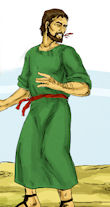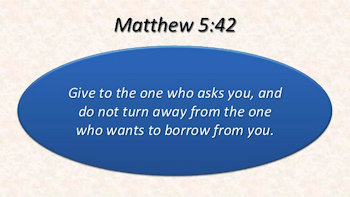During his famous Sermon on the Mount, Jesus said, “You have heard that it was said, ‘An eye for an eye and a tooth for a tooth.’ But I say to you, Do not resist an evildoer. But if anyone strikes you on the right cheek, turn the other also; and if anyone wants to sue you and take your coat, give your cloak as well; and if anyone forces you to go one mile, go also the second mile. Give to everyone who begs from you, and do not refuse anyone who wants to borrow from you,” (Matthew 5:38-42, NRSV).1
Now, let’s be serious — is Jesus teaching us to be wimps?2 Are we to always take the abuse dished out upon us? Should we accept being intimidated or frightened by society or the government? Well, no! That is not the point, at all. Jesus is not teaching us to be weak and lacking in fortitude, and he does not expect us to just sit there and accept whatever ugly things may be done to us. To understand his teaching about retaliation, we must study the above scripture with respect to the culture and politics of the time. We must understand what it was like to be walking in the sandals of those people in his audience.
An eye for an eye.
Jesus said: “You have heard that it was said, ‘An eye for an eye and a tooth for a tooth,’” (Matthew 5:38).
As mentioned, this and the rest of the scripture quoted above, are part of Jesus’ great sermon, his first in fact. It consolidates all the basic religious doctrine of the Torah for a New Covenant Christianity that was to be instituted when he shed his blood on the Cross.3 Those he was speaking to were poor but righteous, unhappy but charitable, kindly but persecuted. They were, also, the despised and ostracized of society.
 Jesus was quoting from the scriptures what everyone would readily recognize as being from the Hebrew Bible. During the time of Moses, although Israel was a religious community, “it was nevertheless a community composed of individual citizens who were to live together in peace and order.” So, Moses ordered regulations concerning the civil laws and dictated civil legislation as rules of behavior in a social setting (Deuteronomy 19:1–22:4).4 Concerning injuries or aggression and corresponding retaliation, he said, “Show no pity: life for life, eye for eye, tooth for tooth, hand for hand, foot for foot,” (Deuteronomy 19:21). Also, see: Exodus 21:24; Leviticus 24:19-20.
Jesus was quoting from the scriptures what everyone would readily recognize as being from the Hebrew Bible. During the time of Moses, although Israel was a religious community, “it was nevertheless a community composed of individual citizens who were to live together in peace and order.” So, Moses ordered regulations concerning the civil laws and dictated civil legislation as rules of behavior in a social setting (Deuteronomy 19:1–22:4).4 Concerning injuries or aggression and corresponding retaliation, he said, “Show no pity: life for life, eye for eye, tooth for tooth, hand for hand, foot for foot,” (Deuteronomy 19:21). Also, see: Exodus 21:24; Leviticus 24:19-20.
The penalties mentioned are an important part of the law. This ‘eye for eye, tooth for tooth,’ etc., “is sometimes misunderstood as a barbaric justification of personal vengeance and maiming. On the contrary, it expresses the just principle that judicial punishments should fit the crime,” thereby actually limiting the permissible punishment. Anyone responsible for the loss of another’s eye deserves, in principle, to give up his own eye, but no more than that. “In practice, however, the offender ordinarily would placate the aggrieved party by paying an amount proportional to the degree of the maiming” as a substitute. It was essentially a fine.5 “The old Torah injunction was not intended to encourage revenge, but to restrict it . . . .”6
If anyone strikes the right cheek, turn the other also.
“But I say to you, Do not resist an evildoer. But if anyone strikes you on the right cheek, turn the other also,” (Matthew 5:39).
At that time in history, turning the other cheek would be a way of counteracting or undermining the power of authority. The Jews were a peaceable people but of a lower socioeconomic class, therefore others of a higher class would assert their authority and dominance through aggression.
 If the person being struck by the hand ‘turned his other cheek’, the person of authority was then faced with a dilemma. A discipliner would strike the persecuted person with the back of his right hand, because the left hand was only used for unclean purposes, so a back-hand strike on the opposite cheek could not be performed.7
If the person being struck by the hand ‘turned his other cheek’, the person of authority was then faced with a dilemma. A discipliner would strike the persecuted person with the back of his right hand, because the left hand was only used for unclean purposes, so a back-hand strike on the opposite cheek could not be performed.7
Also, unless the persecuted person retaliated, someone in authority would never strike the poorer person with the front of his hand or fist, because that would be seen as a statement of equality. “Thus, by turning the other cheek, the persecuted were actually demanding equality.”8
Instead of being fearful, one is demonstrating just the opposite. Avoiding violence is necessary when you know you can’t win, but don’t just walk away. If possible, get your point across to the aggressors, and let them do the walking away. I’m sure those in Jesus’ audience were very interested and enthusiastic about what he was saying.
If they take your coat, give them your cloak as well.
“If anyone wants to sue you and take your coat, give your cloak as well,” (Matthew 5:40).
The Greek word for ‘cloak’ can mean inner or outer apparel, see Notes & References concerning ‘coat’ and ‘cloak’.9
Here, Jesus is talking about a civil suit in a court of law. Because the people he was speaking to were poor, civil suits were common to collect money from the people who had borrowed. If a coat was taken as collateral for a loan, “Jewish law strictly required its return every evening at sunset, because that was all the poor had in which to sleep.” So this situation is one that his audience would have been well familiar — the debtor having sunk ever deeper into poverty, cannot pay the debt, so the creditor sued him for payment.10
If you are going to lose your coat for none payment, then also offer your shirt (tunic) as well. His reasoning is that by giving both, the debtor would have to walk out the court naked and the creditor would be holding all your clothes. It would be unlikely that the creditor would accept the offer and then look bad to the community. “You have suddenly turned the tables on him. You had no hope of winning the trial; the law was entirely in his favor. But you have refused to be humiliated. At the same time you have registered a stunning protest against a system that spawns such debt.”11 Again, Jesus is saying that you may lose your case, but go ahead and make your point. Show you are not afraid, just don’t get violent.
If forced to go a mile, go two.
“If anyone forces you to go one mile, go also the second mile,” (Matthew5:41).
 Why would anyone be forced to walk a mile? The reason is that the Roman military allowed, by law, a soldier to temporality recruit a Jewish native to carry his equipment for one Roman mile.12 After the first mile, they could then conscript someone else for the next mile, or carry it themselves. This idea extended to enlisting temporary help for any number of chores or jobs.
Why would anyone be forced to walk a mile? The reason is that the Roman military allowed, by law, a soldier to temporality recruit a Jewish native to carry his equipment for one Roman mile.12 After the first mile, they could then conscript someone else for the next mile, or carry it themselves. This idea extended to enlisting temporary help for any number of chores or jobs.
“Roman soldiers regularly followed this practice as a practical means of getting things accomplished quickly. They would simply enlist someone to do something, and it was futile to resist.”13 In the books of Matthew, Mark, and Luke, there are described similar accounts of a passer-by being recruited to carry Jesus’ cross.
In that incident, by the way, it was not the complete cross, as shown in movies and paintings, but only the horizontal crossbeam. (For a study on the cross used for Jesus’ crucifixion, see References & Notes at the end of this article.)14 Anyway, Jesus’ advice was to go along with the soldier’s demands willingly, even helping beyond what was asked. By doing so, they showed they were willing to give aid, not being forced to do so.
Give to everyone . . . do not refuse.
“Give to everyone who begs from you, and do not refuse anyone who wants to borrow from you,” (Matthew 5:42).
In Jesus’ illustrations, they were not all meant to be applied literally. This verse is most often seen as a command to be charitable, but it simply means they should not refuse requests, if possible. Martin Luther argued the verse is restricted only to those who need assistance and John Calvin stated that generosity, although important, should never be uncontrolled.15
 Even if you do not have the means to provide what is needed, do not turn away with a silent scowl; look at the person, give them your attention, be pleasant and cheerful. Do what is possible to help, even if it is just an acknowledgment of respect. During Jesus’ day, giving alms — voluntary contributions of food, money, or clothing to aid the poor — was common and viewed highly in the ancient world.16
Even if you do not have the means to provide what is needed, do not turn away with a silent scowl; look at the person, give them your attention, be pleasant and cheerful. Do what is possible to help, even if it is just an acknowledgment of respect. During Jesus’ day, giving alms — voluntary contributions of food, money, or clothing to aid the poor — was common and viewed highly in the ancient world.16
Another interpretation of this verse is that it is not about charity, but rather against loaning for interest. “The word ‘borrow’ here is seen by some as a reference to the lending industry. Jesus is not stating that one should give money to anyone that asks, but rather that it is wrong to demand interest.”17
Conclusion
Jesus was not teaching people to be wimps. He was teaching the oppressed that there was a way they could turn bad situations around and come out a winner. He was keenly aware of the futility of any revolt against Roman power and instructed the oppressed to “assert their human dignity in a situation that cannot, for the time being, be changed.” Instead of retaliating one should do the opposite, and then commit their case to the Lord, who will one day return all things to perfect order, through his own vengeance.18
 The rules may belong to the government, but how you respond to those rules belongs to you. An earthly government has no power over your choice. If you can get the authorities to take you seriously, then maybe they will recognize your humanity.19 These teachings of Jesus have been taken as a manifesto for nonviolence in both the church and much of the world.20
The rules may belong to the government, but how you respond to those rules belongs to you. An earthly government has no power over your choice. If you can get the authorities to take you seriously, then maybe they will recognize your humanity.19 These teachings of Jesus have been taken as a manifesto for nonviolence in both the church and much of the world.20
Jesus did not teach anyone to be wimpy, but he didn’t teach them to take vengeance, either. Paul continued Jesus’ teachings against retaliation and expanded upon it in the book of Romans.
“Do not repay anyone evil for evil, but take thought for what is noble in the sight of all. If it is possible, so far as it depends on you, live peaceably with all. Beloved, never avenge yourselves, but leave room for the wrath of God; for it is written, ‘Vengeance is mine, I will repay, says the Lord. No, ‘if your enemies are hungry, feed them; if they are thirsty, give them something to drink; for by doing this you will heap burning coals on their heads’ Do not be overcome by evil, but overcome evil with good,” (Romans 12:17-21).
Post Script
There are a few songs about the Sermon on the Mount, but I have two favorites at this time. The first is of an old time preacher giving a sermon about the Sermon on the Mount. Here is a selection from the lyrics. If you like Southern Gospel Music, take a listen to this one listed in References & Notes.21
 Well, he looked the congregation right straight in the face,
Well, he looked the congregation right straight in the face,
And then he started preaching ‘bout savin’ grace.
He preached about an hour about the sermon on the mount,
And when he ended up, he had the devil on the route.
He led three songs for the congregation, and knelt in a word of prayer,
He turned to chapter five in Matthew, and he took his text from there.
He preached the real old time salvation, and he certainly proved himself.
For after he extended the invitation, there weren’t any sinners left.
 The other song is both serious and sad. It uses ‘Sermon on the Mount’ as a play-on-words with a double meaning. It is about a cowboy tending a herd of cattle, who would lecture the Gospel to his fellow riders every Sunday. He would preach while sitting in the saddle on his horse — hence, he gave his sermon, on the mount.
The other song is both serious and sad. It uses ‘Sermon on the Mount’ as a play-on-words with a double meaning. It is about a cowboy tending a herd of cattle, who would lecture the Gospel to his fellow riders every Sunday. He would preach while sitting in the saddle on his horse — hence, he gave his sermon, on the mount.
The song is very descriptive. It tells the story with lyrics such as this: “The plains were his cathedral, the saddle his pulpit. His congregation, cowboys with pistols on their hips.” This cowboy sacrificed his life to save many others. (I know you get the point!) If you are a Country Music fan, you may like this one; see References & Notes.22
![]()
Copyright © 2019, Dr. Ray Hermann
OutlawBibleStudent.org
→ Leave comments at the end, after References & Notes.
You can see our basic rules for comments by clicking here.
References & Notes
- All scripture quotations are from the New Revised Standard Version Bible (NRSV), ©1989 the Division of Christian Education of the National Council of the Churches of Christ in the United States of America. Used by permission. All rights reserved.
- wimp \ wimpy: a weak, cowardly, or ineffectual person.
Merriam-Webster’s Collegiate Dictionary, 11th ed., (Springfield, MA: Merriam-Webster, Inc., 2003). - Freeman, James M. and Chadwick, Harold J., Manners & Customs of the Bible, (North Brunswick, NJ: Bridge-Logos Publishers, 1998), p. 407.
- Dockery, David S. (Ed.), Holman Bible Handbook, (Nashville, TN: Holman Bible Publishers, 1992), p. 180.
- Elwell, Walter A. (Ed.), Evangelical Dictionary of Biblical Theology, (Grand Rapids, MI: Baker Books,1996), p. 467.
- Mays, James Luther (Ed.), Harper’s Bible Commentary, (San Francisco: Harper & Row, 1988), p. 957.
- Wink, Walter, Engaging the Powers: Discernment and Resistance in a World of Domination, (Minneapolis MN: Fortress Press, 1992), pp. 175–182.
- Ibid.
- (A) Some people believe this is a mistranslation, because ‘cloak’ should be a coat, but the Greek word can mean inner or outer clothing. Various translations indicate various items; this has been a continuing translation difficulty. See note ‘B’ below for more information.
Strong’s Greek No. 2440: ἱμάτιον; neut. of a presumed der. of ἔννυμι (to put on); a dress (inner or outer):— apparel, cloke, clothes, garment, raiment, robe, vesture.
Strong, James, The New Strong’s Dictionary of Hebrew and Greek Words, (Nashville: Thomas Nelson, 1996).
(B) Another scholar says the following: “The former, the shirt-like under-garment or tunic; the latter, the mantle, or ampler over-garment, which served as a covering for the night, and therefore was forbidden by the Levitical law to be retained in pledge over night (Exod. 22:26, 27).
Vincent, Marvin Richardson, Word Studies in the New Testament, (New York: Charles Scribner’s Sons, 1887), vol. 1, p. 41. - Wink, Walter, “Christian Nonviolence,” (Z-net, Zmag.org, 17 December 2004), from Internet Archive Wayback Machine, https://web.archive.org/web/20070929120921/http://www.zmag.org/content/showarticle.cfm?SectionID=1&ItemID=6889
- Ibid.
- Roman mile: = 1,000 paces, about 1,611 yards or 1,473 meters) — no easy task considering a Roman soldier’s backpack could weigh upwards of 100 pounds (45.4 kg).
“The Extra Mile (disambiguation),” (Wikipedia, Wikimedia Foundation, Inc., 11 December 2019), https://en.wikipedia.org/wiki/The_Extra_Mile_(disambiguation) - Witherington III, Ben, “It’s in the Details,” (Bible Review, October 2004), vol. 20, no. 5, p. 10.
- Hermann, Ray, “Crucifixion of Christ: Was a Cross or Pole Used?” (The Outlaw Bible Student, OBS, 20 June 2018), https://outlawbiblestudent.org/crucifixion-of-christ-was-a-cross-or-pole-used/
- “Matthew 5:42,” (Wikipedia, Wikimedia Foundation, Inc., 2 July 2019), https://en.wikipedia.org/wiki/Matthew_5%3A42
- The NET Bible First Edition Notes, (Richardson, TX: Biblical Studies Press, 2006), Mt 5:42.
- “Matthew 5:42,” (Wikipedia, Wikimedia Foundation, Inc.), see above.
- Barbieri Jr., Louis A., “Matthew,” in The Bible Knowledge Commentary: An Exposition of the Scriptures, (Ed.) J. F. Walvoord and R. B. Zuck,(Wheaton, IL: Victor Books, 1985), vol. 2, p. 31.
- Wink, Walter, “Christian Nonviolence,” (Z-net, Zmag.org, 17 December 2004), from Internet Archive Wayback Machine, https://web.archive.org/web/20070929120921/http://www.zmag.org/content/showarticle.cfm?SectionID=1&ItemID=6889
- Dockery, David S. (Ed.), Holman Bible Handbook, (Nashville, TN: Holman Bible Publishers, 1992), p. 546.
- “That Old-Time Preacher Man,” Artist: Gaither Vocal Band; Author: Bill & Gloria Gaither; Album: Church In The Wildwood, September 2012), – VIDEO: https://youtu.be/KQoCcO_aAOk
- “Sermon on the Mount,” Artist: Tommy Brandt; Album: Never Stop Reaching; (Tommy Brandt Ministries Inc., October 2018), – AUDIO: https://youtu.be/TKWdMBWWgGE


“Jesus did not teach anyone to be wimpy…” Agreed…Case in point, when he threw out the money changers in the temple. That hardly can be categorized as a “wimpy” action. “…but he didn’t teach them to take vengeance, either.” Yes…shown by his non-action as they brutalized him through his trial and crucifixion. Nice article!
Thanks for reading this article and for leaving a comment. Yes, you give two very good examples of his behavior. Although they contrast each other, neither indicate him being cowardly.
This article has caused me to rethink the sermon on the mount. This information would of been really helpful if I had known about it 20 years ago, when it was covered in a church bible study. The idea of eye-for-eye and going the extra mile never made much sense before I read what you wrote. Thank you for your research and the extra notes at the end of the article which gave more knowledge to several things mentioned in the story. I look forward to learning more as time goes on. I’m glad I subscribed to your newsletter to let me know when new items appear.
Thank you for your generous praise and I am happy that the articles have been helpful in your study of God’s word. That is our purpose.
And thanks, also, for the newsletter subscription. I promise you will not be overwhelmed with mailings, as we only send notices a couple of times a month about new articles posted.